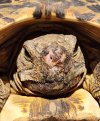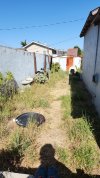coolnewbugs
New Member
Hi everyone,
I recently returned home from college for a few weeks, and was spending some time with my 15 year old leopard tortoise that my mom has been looking after while I've been away.
She is very personable and active, eats very well, and lives in our back yard here on the central coast of California. The yard is mostly sand, and she has a heat mat with plenty of cover and space to roam. Her shell is very pyramided, but it has never seemed to affect her quality of life.
Today I noticed she seemed to be having a difficult time breathing, and upon closer inspection I realized her nostrils were almost completely covered by skin growth. Her beak is a dark color, and I've feared she has had some kind of mouth rot for a while now. I followed suggestions on another post to this forum and after soaking her, gently removed the obstructing skin with a cue tip. She seems to be breathing more easily now, but her nose is raw and pink. I've disinfected the area with hydrogen peroxide, but I'm still very worried about whether I did the right thing or not, and if a vet visit is needed. She has had minor beak injuries before from unknown causes, I suspected it was from eating off of a rough concrete slab. Any advice is greatly appreciated, thank you!
In the attached picture you can see her poor face, it looks pretty rough. She loves the grassland tortoise mix wet food, so a lot of that is dried to her beak as well.
- Isaac
I recently returned home from college for a few weeks, and was spending some time with my 15 year old leopard tortoise that my mom has been looking after while I've been away.
She is very personable and active, eats very well, and lives in our back yard here on the central coast of California. The yard is mostly sand, and she has a heat mat with plenty of cover and space to roam. Her shell is very pyramided, but it has never seemed to affect her quality of life.
Today I noticed she seemed to be having a difficult time breathing, and upon closer inspection I realized her nostrils were almost completely covered by skin growth. Her beak is a dark color, and I've feared she has had some kind of mouth rot for a while now. I followed suggestions on another post to this forum and after soaking her, gently removed the obstructing skin with a cue tip. She seems to be breathing more easily now, but her nose is raw and pink. I've disinfected the area with hydrogen peroxide, but I'm still very worried about whether I did the right thing or not, and if a vet visit is needed. She has had minor beak injuries before from unknown causes, I suspected it was from eating off of a rough concrete slab. Any advice is greatly appreciated, thank you!
In the attached picture you can see her poor face, it looks pretty rough. She loves the grassland tortoise mix wet food, so a lot of that is dried to her beak as well.
- Isaac

